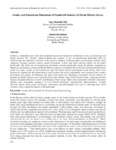Gender and Educational Dimensions of Handicraft Industry in Mwala District, Kenya
Abstract
In Kenya, communities have since time immemorial practised indigenous technologies such as woodcarving and
basket weaving. The “kiondo” (African Basket) for example, is now an international handicraft while the
woodcarvings are exported to all parts of the world as artefacts. In Kenya today, woodcarvings, basketry, Kisii
soapstone carvings, jewellery, pottery, gourd decorations, T-shirts and kikois (African shawl), are the major
handicrafts. The study was on woodcarving and basket weaving handicrafts among the Kamba community in
Wamunyu and Katangi locations of Mwala District in Kenya. It examined the gender and educational dimensions
of the two crafts. A total of 100 woodcarvers and 100 basket weavers participated in the survey. These were
purposively sampled for the reason that in each location, the target respondents were organised into a major
association and groups. In Wamunyu the major association was Wamunyu Cooperative Society whereas in
Katangi the basket weavers were organized into groups namely; Yatta South Women Group; Syokisinga Women
Group; Assumption Resource Centre; and Katanga women group. Other study respondents included cooperative
officials and, programme managers of local Non-Governmental Organisations. Questionnaires, in-depth
interview guides, focus group discussions, observation and photography were used in collecting data which
revealed certain significant aspects of the handicraft.

